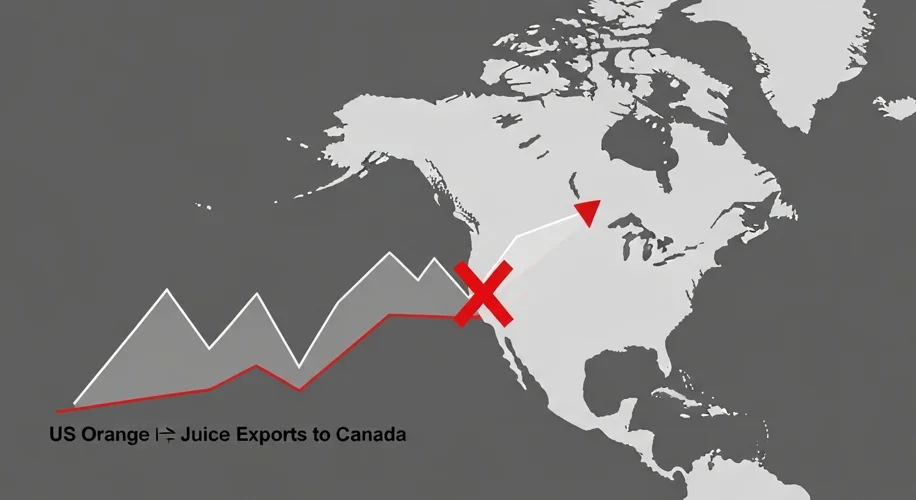In the annals of international trade, few disputes are as refreshingly peculiar as the quiet friction between the United States and Canada over orange juice. For a time, during the late 20th century, shipments of Florida’s golden nectar to the Great White North dwindled, not due to tariffs or geopolitical squabbles, but because of something far more subtle: a Canadian skepticism towards American orange juice, particularly the kind that flowed so freely from the sun-drenched groves of Florida.
This wasn’t a sudden storm, but a slow drizzle of discontent, a cultural eddy that disrupted the usual flow of commerce. While Canadians are known for their polite, often reserved nature, their tastes, it seems, could be surprisingly firm. The story of this “Great OJ Embargo,” as it might be whimsically termed, offers a fascinating glimpse into how consumer perception, national identity, and even agricultural practices can shape cross-border trade in unexpected ways.
Florida, with its vast orange orchards, became synonymous with orange juice for much of the United States. The image of sunshine, relaxation, and a healthy start to the day was deeply ingrained in the American psyche. Post-World War II America saw a boom in processed foods and beverages, and orange juice, often fortified with Vitamin C, became a breakfast staple, a symbol of American prosperity and vitality. The ubiquitous presence of Florida OJ in American households created an expectation that this would be the same for their northern neighbors.
However, Canada’s own agricultural landscape and historical development painted a different picture. While Canada does produce some fruit juices, its climate is not conducive to large-scale citrus cultivation. This meant that Canadians were, by necessity, more reliant on imported juices. For a long time, the Canadian market was accustomed to a wider variety of juice imports, and perhaps, a different quality standard, or at least, a different perception of quality. Furthermore, Canada’s own dairy industry, particularly its milk production, was robust and deeply integrated into the national diet. The marketing and cultural significance of milk might have provided a different backdrop against which other beverages were judged.

The roots of Canadian skepticism towards Florida orange juice were multifaceted. Some reports suggest that Canadian consumers found the taste of Florida OJ, particularly the concentrated and reconstituted varieties that became popular in the U.S., to be too artificial or lacking in the fresh, vibrant flavor they preferred. There were whispers, often amplified in consumer forums and food publications of the era, about the processing methods used in Florida. While these methods were perfectly legal and safe in the U.S., they perhaps didn’t align with what some Canadian consumers considered natural or premium.
This wasn’t necessarily about overt protectionism by the Canadian government, but rather a subtle shift in consumer preference, a quiet rebellion against what was perceived as a less-than-ideal product. It’s possible that Canadian juice producers, while not producing oranges themselves, might have focused on blending or marketing imported juices in ways that appealed more to the local palate. The emphasis might have been on single-source juices or those with a less processed image, creating a contrast with the dominant Florida brands.
The narrative that emerged was one where Canadian consumers, when given a choice, gravitated towards alternatives. This could have included juices from other U.S. states or even other countries, or perhaps a general preference for other beverages altogether. The perception was that if they were going to import orange juice, they wanted something that stood out, something that wasn’t just a generic, mass-produced product.

The consequences of this subtle trade friction were tangible, though perhaps not catastrophic on a global scale. For Florida citrus growers, the Canadian market, while significant, represented just one of many international avenues. However, a consistent decline in demand meant lost revenue and a need to re-evaluate export strategies. It highlighted a critical lesson in international trade: understanding and adapting to local tastes and perceptions is as crucial as meeting regulatory standards.
The story also speaks volumes about the power of consumer perception. Even when a product is widely accepted and consumed in its home market, it can face challenges abroad if it doesn’t resonate with local cultural preferences or if competing narratives about its quality take hold. The “Great OJ Embargo” wasn’t a war waged with cannons, but a quiet, persistent negotiation conducted at the checkout counter and in the grocery aisles.
In retrospect, this episode serves as a charming, albeit niche, case study in the complexities of global commerce. It reminds us that behind every trade statistic, there are often deeply human elements: preferences, traditions, and the simple, yet powerful, notion of what tastes good. While the fervor around this specific trade dynamic may have cooled, the lesson remains: the sunshine of Florida might be universally appealing, but the palate of its neighbors is a territory that requires careful cultivation and a deep understanding of what truly satisfies.

Ultimately, the market dynamics shifted, and perceptions may have evolved over time with new processing technologies and marketing approaches. However, the period when Canada’s skepticism created a noticeable dip in Florida’s orange juice exports remains a curious footnote in the history of North American trade relations, a testament to the subtle yet powerful influence of taste and cultural perception.

